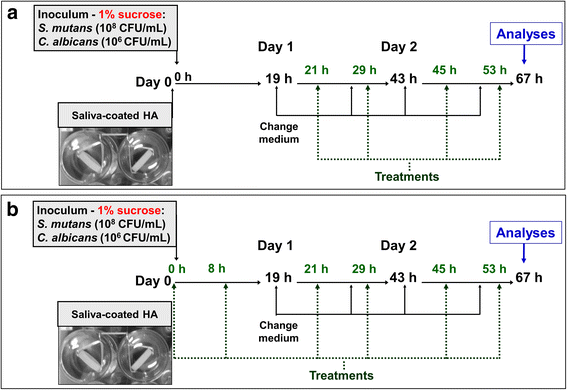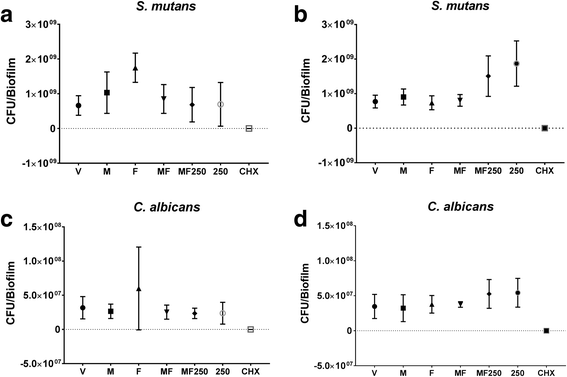Effect of tt-farnesol and myricetin on in vitro biofilm formed by Streptococcus mutans and Candida albicans
- PMID: 29444673
- PMCID: PMC5813409
- DOI: 10.1186/s12906-018-2132-x
Effect of tt-farnesol and myricetin on in vitro biofilm formed by Streptococcus mutans and Candida albicans
Abstract
Background: Dental caries is considered a multifactorial disease, in which microorganisms play an important role. The diet is decisive in the biofilm formation because it provides the necessary resources for cellular growth and exopolysaccharides synthesis. Exopolysaccharides are the main components of the extracellular matrix (ECM). The ECM provides a 3D structure, support for the microorganisms and form diffusion-limited environments (acidic niches) that cause demineralization of the dental enamel. Streptococcus mutans is the main producer of exopolysaccharides. Candida albicans is detected together with S. mutans in biofilms associated with severe caries lesions. Thus, this study aimed to determine the effect of tt-farnesol and myricetin topical treatments on cariogenic biofilms formed by Streptococcus mutans and Candida albicans.
Methods: In vitro dual-species biofilms were grown on saliva-coated hydroxyapatite discs, using tryptone-yeast extract broth with 1% sucrose (37 °C, 5% CO2). Twice-daily topical treatments were performed with: vehicle (ethanol 15%, negative control), 2 mM myricetin, 4 mM tt-farnesol, myricetin + tt-farnesol, myricetin + tt-farnesol + fluoride (250 ppm), fluoride, and chlorhexidine digluconate (0.12%; positive control). After 67 h, biofilms were evaluated to determine biofilm biomass, microbial population, and water-soluble and -insoluble exopolysaccharides in the ECM.
Results: Only the positive control yielded a reduced quantity of biomass and microbial population, while tt-farnesol treatment was the least efficient in reducing C. albicans population. The combination therapy myricetin + farnesol + fluoride significantly reduced water-soluble exopolysaccharides in the ECM (vs. negative control; p < 0.05; ANOVA one-way, followed by Tukey's test), similarly to the positive control.
Conclusions: Therefore, the combination therapy negatively influenced an important virulence trait of cariogenic biofilms. However, the concentrations of both myricetin and tt-farnesol should be increased to produce a more pronounced effect to control these biofilms.
Keywords: Candida albicans; Cariogenic biofilm; Myricetin; Streptococcus Mutans; Topical treatment; tt-farnesol.
Conflict of interest statement
Ethics approval and consent to participate
All volunteers received an explanation about the study and consented to donated saliva for pellicle formation by signing an informed consent term. The study was approved by the Institutional Ethical Committee at São Paulo State University (Unesp), School of Dentistry, Araraquara. (CAAE: 31.725.114.8.0000.5416).
Consent for publication
“Not applicable”. Saliva samples were pooled without volunteer identification.
Competing interests
The authors declare that they have no competing interests.
Publisher’s Note
Springer Nature remains neutral with regard to jurisdictional claims in published maps and institutional affiliations.
Figures





Similar articles
-
Modulation of Lipoteichoic Acids and Exopolysaccharides Prevents Streptococcus mutans Biofilm Accumulation.Molecules. 2020 May 9;25(9):2232. doi: 10.3390/molecules25092232. Molecules. 2020. PMID: 32397430 Free PMC article.
-
Impact of farnesol and Corsodyl® on Candida albicans forming dual biofilm with Streptococcus mutans.Oral Dis. 2018 Sep;24(6):1126-1131. doi: 10.1111/odi.12873. Epub 2018 Jun 8. Oral Dis. 2018. PMID: 29667274
-
Distinct Agents Induce Streptococcus mutans Cells with Altered Biofilm Formation Capacity.Microbiol Spectr. 2022 Aug 31;10(4):e0065022. doi: 10.1128/spectrum.00650-22. Epub 2022 Jul 11. Microbiol Spectr. 2022. PMID: 35862994 Free PMC article.
-
Oral microecological community- Streptococcus mutans dysbiosis and interaction provide therapeutic perspectives for dental caries.Arch Oral Biol. 2025 Oct;178:106367. doi: 10.1016/j.archoralbio.2025.106367. Epub 2025 Aug 6. Arch Oral Biol. 2025. PMID: 40812045 Review.
-
Inhibition of Streptococcus mutans biofilm formation by strategies targeting the metabolism of exopolysaccharides.Crit Rev Microbiol. 2021 Sep;47(5):667-677. doi: 10.1080/1040841X.2021.1915959. Epub 2021 May 3. Crit Rev Microbiol. 2021. PMID: 33938347 Review.
Cited by
-
Management of Streptococcus mutans-Candida spp. Oral Biofilms' Infections: Paving the Way for Effective Clinical Interventions.J Clin Med. 2020 Feb 14;9(2):517. doi: 10.3390/jcm9020517. J Clin Med. 2020. PMID: 32075040 Free PMC article. Review.
-
LiaS gene from two-component system is essential for caries pathogenicity in dual-species biofilms of Streptococcus mutans and Candida albicans.Front Microbiol. 2025 Jul 31;16:1612841. doi: 10.3389/fmicb.2025.1612841. eCollection 2025. Front Microbiol. 2025. PMID: 40822408 Free PMC article.
-
Electrostatic Interactions Enable Nanoparticle Delivery of the Flavonoid Myricetin.ACS Omega. 2020 May 28;5(22):12649-12659. doi: 10.1021/acsomega.9b04101. eCollection 2020 Jun 9. ACS Omega. 2020. PMID: 32548448 Free PMC article.
-
Roles of Streptococcus mutans-Candida albicans interaction in early childhood caries: a literature review.Front Cell Infect Microbiol. 2023 May 16;13:1151532. doi: 10.3389/fcimb.2023.1151532. eCollection 2023. Front Cell Infect Microbiol. 2023. PMID: 37260705 Free PMC article. Review.
-
Antibiofilm Efficacy of Luteolin Against Single and Dual Species of Candida albicans and Enterococcus faecalis.Front Microbiol. 2021 Oct 15;12:715156. doi: 10.3389/fmicb.2021.715156. eCollection 2021. Front Microbiol. 2021. PMID: 34721318 Free PMC article.
References
-
- Bagramian RA, Garcia-Godoy F, Volpe AR. The global increase in dental caries. A pending public health crisis. Am J Dent. 2009;21:3–8. - PubMed
-
- Kidd EA, Fejerskov O. What constitutes dental caries? Histopathology of carious enamel and dentin related to the action of cariogenic biofilms. J Dent Res. 2004;83 Spec No C:C35–C38. - PubMed
MeSH terms
Substances
Grants and funding
LinkOut - more resources
Full Text Sources
Other Literature Sources

